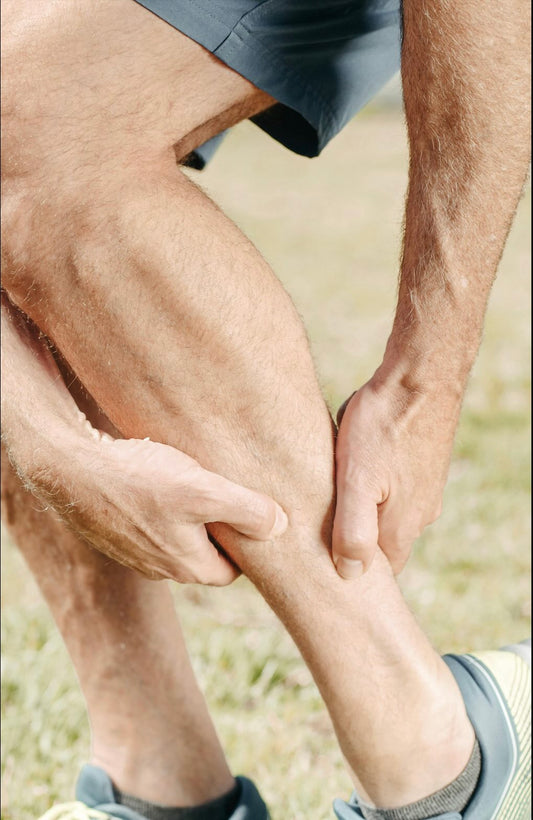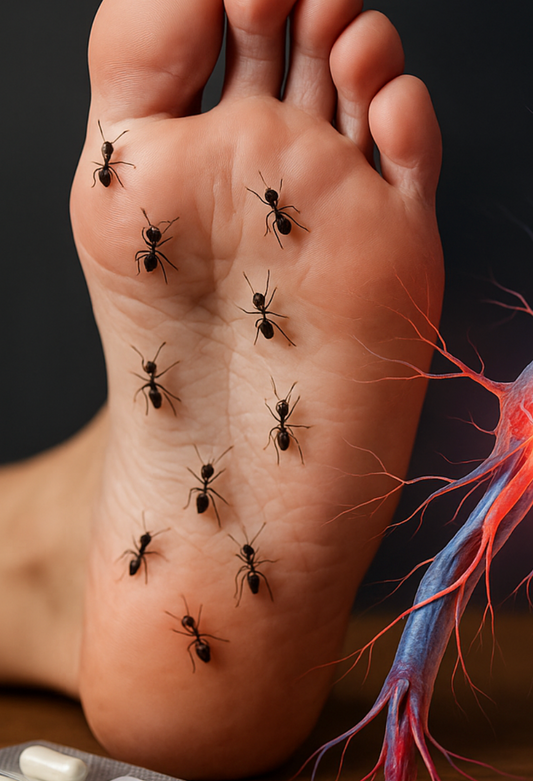Strategies against fatigue and lack of energy in nerve damage
Are you suffering from persistent fatigue and exhaustion that could be caused by polyneuropathy? Perhaps you feel like even small everyday tasks are a challenge and you constantly lack energy. Polyneuropathy is a condition in which the peripheral nerves are damaged, and it can not only cause pain and numbness, but also lead to significant fatigue. In this detailed article, we will take a deeper look at how the nerve damage of polyneuropathy contributes to a lack of energy, what strategies can help you, and the role of study results and professional recommendations.
Why Polyneuropathy Can Be So Debilitating
Polyneuropathy refers to damage to the peripheral nerves, i.e. those nerves that are located outside the brain and spinal cord. Depending on the cause (e.g. diabetes, vitamin deficiency, autoimmune diseases or toxic influences), this nerve damage can affect different areas, but mostly the hands and feet. Typical symptoms are tingling, numbness, burning pain or reduced sensitivity.
But while many people think of polyneuropathy primarily as pain or numbness, they often overlook the extent to which the disease affects general energy. And this is by no means just imagination: A study in the Journal of Clinical Neuromuscular Disease (2017) pointed out that a significant proportion of patients with polyneuropathy complain of chronic fatigue - a tiredness that cannot simply be banished with a few extra hours of sleep. The physical and psychological stress caused by constant discomfort, pain and insecurity in movement can literally "drain" the nervous system and the entire organism.
Causes of Fatigue in Polyneuropathy
Exhaustion, also known as fatigue, has several possible causes in polyneuropathy. On the one hand, the constant pain at the nerve endings can keep the body on alert. If you constantly have to process unclear signals, it exhausts you mentally and physically. A study in the European Journal of Neurology (2015) suggested that persistent pain can disrupt the balance of neurotransmitters (such as serotonin and dopamine). If your brain doesn't get a "break" from the pain, it releases more stress hormones, which can increase the state of exhaustion.
On the other hand, your movement pattern is often affected. For example, if you have foot pain or numbness, you move more cautiously, tense certain muscle groups more or avoid certain activities, which ultimately leads to muscle loss and reduced endurance. A vicious circle can develop: the reduced activity weakens the body, which promotes exhaustion, and the exhaustion makes it even more difficult to get moving at all.
A third factor is that polyneuropathy is often associated with other chronic diseases (e.g. diabetes). Anyone who has to constantly monitor their blood sugar or take additional medication experiences psychological stress. The stress that a chronic disease causes can encourage depression or anxiety disorders. And depression and anxiety are closely intertwined with fatigue - firstly because you feel psychologically exhausted, and secondly because sleep disorders can occur.
What studies say about fatigue in neurological diseases
While research into polyneuropathy often focuses on pain and sensory disturbances, there are also studies that explicitly examine fatigue. In a paper published in Neuromuscular Disorders (2018), the authors found that approximately 60 percent of polyneuropathy patients surveyed suffered from moderate to severe fatigue. The exhaustion manifested itself in low physical resilience, mental sluggishness and a high need for sleep.
Another study in Pain Practice (2019) highlighted that fatigue is often underestimated in polyneuropathies and is often the main reason why those affected are no longer able to work. Participants reported that, in addition to physical pain, they particularly suffered from the feeling of "never having enough energy for the day". This form of persistent fatigue reduced their quality of life more than the actual pain.
Exactly which mechanisms are responsible for the severe fatigue is not yet fully understood. Several factors are probably involved: Chronic pain activates the sympathetic nervous system (stress mode), while natural regeneration is impaired by sleep disorders and "restless legs". Hormonal imbalances (e.g. adrenal cortex, thyroid) can also play a role. A team led by neurologist Dr. Mason at the University of Southampton (2020) emphasized that an integrative consideration of pain, sleep quality and mental state is necessary to help patients regain their energy.
Everyday Strategies Against Exhaustion
The good news: There are numerous strategies to escape this vicious cycle of lack of energy and pain, or at least to alleviate it. However, it takes time, patience and a certain willingness to experiment until you find out which approaches work best for you.
pacing and energy management
A concept that comes from the treatment of chronic fatigue syndrome (CFS/ME) is "pacing." This means dividing your day into small, manageable chunks and planning generous rest periods before exhaustion overwhelms you. Instead of being active for long periods at a time, take a real break after each short activity, during which you sit down, meditate, or just breathe. This is especially important for people with polyneuropathy because your body can quickly get into a state of pain or tension if you keep going for too long.
Conscious Movement
Exercise may seem counterintuitive when you're already suffering from fatigue, but moderate physical activity can improve circulation and boost metabolism, which in the long run means more energy. A study by the Archives of Physical Medicine and Rehabilitation (2016) showed that light exercise programs adapted to the symptoms (e.g. water aerobics, moderate cycling, brisk walking) not only improved muscle strength but also the well-being of people with polyneuropathy. It is important not to overexert yourself. A physical therapist can help create a plan that takes your individual limits into account.
Nutrition for more energy
Diet plays a major role, especially in cases of nerve disorders. A stable blood sugar level can help to avoid energy crashes that make you even more tired. High-quality proteins, healthy fats (e.g. omega-3 fatty acids) and fiber support the body in cell repair and in stabilizing hormone levels. Experts often recommend avoiding simple carbohydrates (sugar, white flour) as much as possible because they lead to rapid spikes in blood sugar. In diabetes-related polyneuropathy, blood sugar control is essential anyway: any improvement in glycemic control can help to slow the progression of nerve damage.
reduce stress
Chronic stress puts immense strain on the body and can keep the nervous system on alert. Relaxation techniques such as autogenic training, progressive muscle relaxation according to Jacobson or mindfulness meditation can help to calm the body and mind. According to a study in the Journal of Psychosomatic Research (2019), pain patients who do 10 to 20 minutes of mindfulness exercises every day benefit significantly in terms of exhaustion and sleep quality. If you are struggling with polyneuropathy, any measure that lowers your stress level is potentially a help against fatigue.
Medical support
In addition to self-help strategies, medical approaches may also be necessary to get your exhaustion under control.
pain therapy
If your pain is the primary cause of sleep disorders and exhaustion, it is worth experimenting with painkillers or pain therapies. Appropriate pain therapy can ease your daily life to such an extent that you find space for regenerative activities. A study in the Clinical Journal of Pain (2018) showed that patients with well-adjusted pain medication were more able to cope with lighter sports and everyday activities, which in turn gave them back their energy.
vitamin and nutrient deficiencies
Polyneuropathy can be caused or exacerbated by deficiencies in vitamin B12, B1 or other B vitamins. Such deficiencies often manifest themselves in additional fatigue and poor concentration. A careful laboratory analysis can reveal whether you need appropriate supplements. Magnesium or coenzyme Q10 could also play a role, although studies in this area are not yet clear.
Psychological counseling and behavioral therapy
If you constantly feel like you don't have enough energy, are in a depressive mood or find yourself in spirals of rumination, psychological therapy can help break the spiral of pain, fatigue and negative thinking. According to a review in the Journal of Affective Disorders (2020), cognitive behavioral therapies aimed at managing pain can also improve the subjective feeling of fatigue.
Special medications against fatigue
In severe cases, you can discuss with your doctor whether to use medication that has a wake-up or motivation-enhancing effect, similar to those sometimes used for multiple sclerosis or depression. However, this approach is controversial and not the norm because it often has side effects.
A Look at Sleep and Recovery
Sleep is the crucial phase in which your body regenerates and nerve cells carry out repair processes. Many people with polyneuropathy experience sleep disorders: nighttime pain, cramps, restless legs or fear of nighttime pain attacks can fragment sleep. The result: you don't wake up refreshed and fatigue continues to increase.
sleep hygiene
Use basic tips such as a quiet, dark sleeping environment, a comfortable room temperature (ideally between 16 and 18 degrees Celsius) and avoiding caffeine in the late afternoon. You should also avoid using your cell phone or watching TV right before going to bed.
relief in the evening
If your feet hurt, a warm foot bath or a light foot massage can improve circulation and relax you. Warming creams or medicinal ointments can help to reduce the discomfort.
tea blends
Mild calming teas (e.g. made from valerian, lemon balm or lavender) have been linked to improved sleep patterns in some studies (such as in Phytotherapy Research , 2015). While they are not a "miracle cure," they can provide mild support for sleep problems.
sleep diary
If you have trouble sleeping every night, it might be helpful to keep a sleep diary and make detailed notes about sleep duration, pain intensity and possible triggers. This data can help doctors or pain therapists to take targeted measures.
How to support your psyche and your social environment
Chronic fatigue and pain can be very isolating. You may feel that friends or colleagues don't understand why you keep cancelling or withdrawing early. This feeling of withdrawal can increase stress levels and encourage depression. Consider telling people around you about your illness and the level of exhaustion it causes. Sometimes it's enough to explain that you need to manage your energy better because of your polyneuropathy.
Self-help groups or online forums offer the opportunity to exchange experiences with other sufferers. A study published in BMJ Open (2018) showed that patients with chronic pain and fatigue who regularly attended self-help groups experienced fewer depressive episodes and felt more competent in dealing with their limitations. It can be an enormous relief to exchange ideas with people who have to overcome similar challenges.
If you notice that the issue is really bothering you, psychological therapy could help. Cognitive behavioral therapy (CBT) or acceptance and commitment therapy (ACT) give you tools to deal with chronic pain and fatigue more constructively, adjust unrealistic expectations and break negative thought patterns. The Journal of Behavioral Medicine (2019) described that a majority of patients not only reported less pain after six weeks of behavioral therapy, but also felt less exhaustion.
Practical energy routines for everyday life
-
Use power naps in a targeted manner
A short “energy nap” of no more than 20 minutes in the early afternoon can work wonders. However, you should be careful not to fall into a deep sleep so as not to disturb your night’s sleep. -
breathing exercises
One method often recommended in physical therapy or yoga is deep abdominal breathing. You sit upright, breathe deeply into your stomach through your nose, hold your breath briefly and then breathe out slowly through your mouth. Repeat this 5-10 times. Studies in the Journal of Pain and Relief (2017) suggested that such breathing exercises can slightly reduce pain and stress hormone levels, which indirectly provides more energy. -
mini workouts
A few light exercises in the morning or in between can get your circulation going without overtaxing you. These can be simple stretches, a moderate walk or arm circles. -
Structured daily planning
If you are most productive in the morning, plan to do more strenuous activities during this time. Do easier tasks when your energy levels are at their lowest. Also plan nice rituals to motivate yourself (e.g. a cup of tea in the garden, a quick chat with a friend).
Outlook and scientific trends
Medical research increasingly seems to indicate that fatigue should be taken seriously as a separate symptom of polyneuropathy - and not just as a side effect of pain or sensory impairment. Special rehabilitation programs that combine endurance and strength training with psychological support could become standard. There are also initial tests with new active ingredients that specifically target inflammatory processes in the nervous system and thus indirectly increase energy.
In the coming years, we will probably learn more about the role of the microbiome, inflammatory processes and mitochondrial dysfunction in polyneuropathy and fatigue. Some hypotheses suggest that the mitochondria (the "power plants" in our cells) work less efficiently due to long-term nerve inflammation. A study in Frontiers in Neurology (2022) raised the question of whether certain antioxidants or coenzyme Q10 supplements could help increase energy production at the cellular level. However, the results are not yet clear.
Conclusion
Exhaustion and chronic fatigue are a serious problem for many people with polyneuropathy. The damage to the peripheral nerves often leads to a vicious circle of pain, sleep disorders, limited mobility and mental stress. Studies such as those from the Journal of Clinical Neuromuscular Disease (2017) or Pain Practice (2019) underline how much fatigue can reduce the quality of life - sometimes even more than the actual pain.
Nevertheless, there are many different approaches to actively combat this lack of energy: from well-thought-out energy management (pacing) to targeted exercise therapy and dietary adjustments to pain therapy and psychological support. It is important that you find a balance that does not overtax your body, but gradually opens up new reserves of energy. Sleep hygiene, breathing exercises, short power naps or mini workouts can help you make progress day by day. Try to set your goals realistically and seek medical advice if necessary - be it from neurologists, physiotherapists or psychotherapists. After all, polyneuropathy does not necessarily mean giving up a fulfilling and active life. With the right strategies, you can learn to manage your energy resources and maintain your zest for life despite nerve damage.















